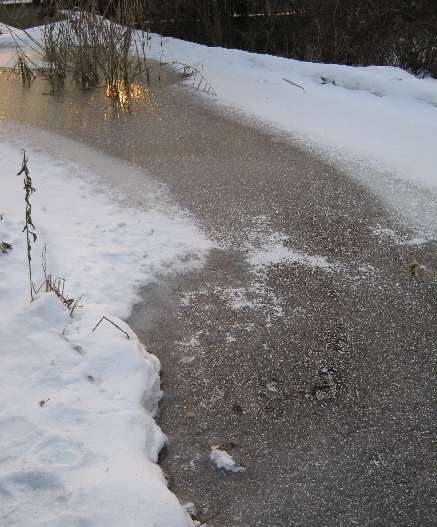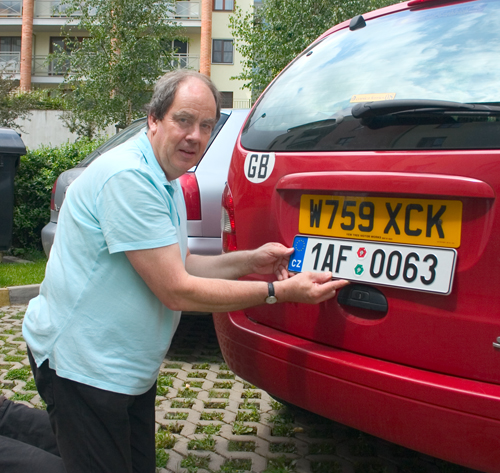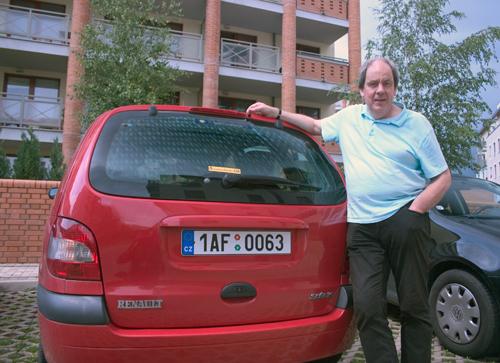
In more than one previous blog post, I have mentioned the extremely helpful website expats.cz. For example, it was through the forum on their website that I found Adrian Blank of Nepomuk to help me through the various hoops in order to register my right-hand drive car here in the Czech Republic.
As well as their website, expats.cz also annually publishes the ‘Czech Republic Survival Guide & Business Directory’. A new edition comes out around the end of September each year. We discovered the then new edition of the ‘Survival Guide for 2009’ within a few days of our arrival in Prague back in September 2008. At that time, expats.cz were specifically asking for new locations from which the guide could be distributed to English-speaking expats. Finding it such a useful source of information ourselves, we offered to take copies to distribute to newcomers who come to St. Clement’s Church and ask for one of our welcome booklets. Since then, we have distributed around forty copies each year.
The ‘Survival Guide’ is distributed free of charge as the cost of production is more than covered by advertising. It contains a great deal of highly useful information that any expat coming to live in the Czech Republic might need, covering employment and business, accommodation and real estate, health, education and leisure activities. This page of the expats.cz website gives full details of the guide including the claim that it is, “Known locally as the expat ‘bible’”.
Each of the three editions that we have previously helped distribute have included just over a page entitled ‘Religion in Prague’ giving basic details of the English-speaking Churches as well as contact information for other faith groups. Therefore, when I discovered whilst attending and exhibiting at the Expats Expo on Saturday 8th October, an event sponsored by expats.cz, that the new 2012 edition of the ‘Survival Guide’ was now available, I picked up a copy for myself and made a mental note to go to the expats.cz office during the following week, in order to pick up a supply of the new edition to distribute from Church.
The first thing I did upon picking up my copy of the 2012 ‘Survival Guide’ was to check that the information about St. Clement’s Anglican Episcopal Church was accurate. I went to the contents pages at the front and then to the index at the back, to try and find ‘Churches’ or ‘Religion’. Could I find the information? No – because the 2012 edition of the so-called ‘expat bible’, has been published with all information about both Christian Churches and other religions, completely eliminated.
As well as immediately speaking with two staff members on the expats.cz stand, both of whom claimed to know nothing about the decision to exclude all information about religion, I also sent off a strongly worded email via the ‘contact us’ page of their website. When several days later, I had not received a reply, I rang the expats.cz office. No one there would admit to having even seen my email. But about half-an-hour later, my phone call was returned by their Creative Director Dominic Bignal, who also claimed not to have seen my email but knew about my complaint from feedback from the staff members on their stand to whom I had spoken.
There followed a rather interesting twenty minute phone discussion. Mr Bignall’s main points were as follows.
- They had to reduce the size of the new 2012 ‘Survival Guide’ from 220 to 200 pages because of not having sold sufficient advertising, therefore something had to go.
- They had judged what to include or exclude based on the number of visits to the various parts of their website.
- If we had paid for an advertisement then we would have been included.
- Going to Church was so specialised that if people wanted to find us, they would.
I have to say, as I also personally told Mr Bignall, that none of these arguments hold water and/or contradict what expats.cz claims.
- If they needed to reduce the size of the ‘Survival Guide’ by twenty pages in order to be commercially viable, why didn’t they just slightly edit down each section rather than completely cut out one section? Allowing for the fact that 25% of guide is advertising, they needed to reduce about 165 pages of text to around 150 – hardly an impossible task.
- How does expats.cz know that what people look for on the website is the same as what they look for in the ‘Survival Guide’? Bearing in mind that the information about Churches is already well hidden on the website, it’s not surprising that it doesn’t get so many visitors.
- Expats.cz claim to provide unbiased information. But if you advertise……
- The last argument can apply to anything that appears in the ‘Survival Guide’. Yes – put ‘English-speaking Church, Prague’ into Google and up will pop St. Clement’s and six or seven other possibilities. But the same applies to Tennis Clubs, Museums, gay bars etc, all of which are included. It is an argument for the ‘Survival Guide’ not to exist in the first place.
What expats.cz (or Howlings s.r.o. – the company who run the website & publish the guide) have done, is a combination of discrimination and ignorance. Discrimination against those who practice the Christian or any other religious faith. Ignorance in thinking we are so small a group of people that we can be safely ignored.
As a commercial organisation, expats.cz/ Howlings s.r.o. are free to choose what they include in their annual ‘Survival Guide’ and what they exclude – a point Dominic Bignall reiterated to me several times over during our phone conversation. Whilst this is true, they also claim that their ‘Survival Guide’ is ‘Prague’s most comprehensive and objective expat publication guide’. As far as I am concerned, following their unilateral decision to exclude all information about the practice of religious faith, both Christian and otherwise, their guide is no longer comprehensive and certainly not objective.












